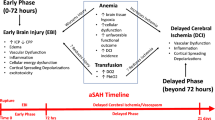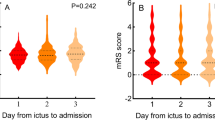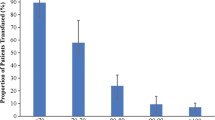Abstract
Background and Purpose
In patients with subarachnoid hemorrhage (SAH), higher hemoglobin (HGB) has been associated with better outcomes, but packed red blood cell (PRBC) transfusions with worse outcomes. We performed a prospective pilot trial of goal HGB after SAH.
Methods
Forty-four patients with SAH and high risk for vasospasm were randomized to goal HGB concentration of at least 10 or 11.5 g/dl. We obtained blinded clinical outcomes at 14 days (NIH Stroke Scale and modified Rankin Scale, mRS), 28 days (mRS), and 3 months (mRS), and blinded interpretation of brain MRI for cerebral infarction at 14 days. This trial is registered at www.stroketrials.org.
Results
Forty-four patients were randomized. Patients with goal HGB 11.5 g/dl received more PRBC units per transfusion [1 (1–2) vs. 1 (1–1), P < 0.001] and more total PRBC units [3 (2–4) vs. 2 (1–3), P = 0.045]. Prospectively defined safety endpoints were not different between groups. HGB concentration was different between study groups from day 4 onwards. The number of cerebral infarctions on MRI (6 of 20 vs. 9 of 22), NIH Stroke Scale scores at 14 days [1 (0–9.75) vs. 2 (0–16)], and rates of independence on the mRS at 14 days (65% vs. 44%) and 28 days (80% vs. 67%) were similar, but favored higher goal HGB (P > 0.1 for all).
Conclusions
Higher goal hemoglobin in patients with SAH seems to be safe and feasible. A phase III trial of goal HGB after SAH is warranted.


Similar content being viewed by others
References
Adam RC, Lundy JS. Anesthesia in cases of poor risk: some suggestions for decreasing the risk. Surg Gynecol Obstet. 1942;74:1011–101.
Hebert PC, Wells G, Blajchman MA, Marshall J, Martin C, Pagliarello G, Tweeddale M, Schweitzer I, Yetisir E. A multicenter, randomized, controlled clinical trial of transfusion requirements in critical care. Transfusion requirements in critical care investigators, Canadian critical care trials group. N Engl J Med. 1999;340:409–17.
McIntyre LA, Fergusson DA, Hutchison JS, Pagliarello G, Marshall JC, Yetisir E, Hare GM, Hebert PC. Effect of a liberal versus restrictive transfusion strategy on mortality in patients with moderate to severe head injury. Neurocrit Care. 2006;5:4–9.
Gerber DR. Transfusion of packed red blood cells in patients with ischemic heart disease. Crit Care Med. 2008;36:1068–74.
Napolitano LM, Kurek S, Luchette FA, Corwin HL, Barie PS, Tisherman SA, Hebert PC, Anderson GL, Bard MR, Bromberg W, Chiu WC, Cipolle MD, Clancy KD, Diebel L, Hoff WS, Hughes KM, Munshi I, Nayduch D, Sandhu R, Yelon JA. Clinical practice guideline: Red blood cell transfusion in adult trauma and critical care. Crit Care Med. 2009;37:3124–57.
Frontera JA, Fernandez A, Schmidt JM, Claassen J, Wartenberg KE, Badjatia N, Connolly ES, Mayer SA. Defining vasospasm after subarachnoid hemorrhage: what is the most clinically relevant definition? Stroke. 2009;40:1963–8.
Wartenberg KE, Schmidt JM, Claassen J, Temes RE, Frontera JA, Ostapkovich N, Parra A, Connolly ES, Mayer SA. Impact of medical complications on outcome after subarachnoid hemorrhage. Crit Care Med. 2006;34:617–23. quiz 624.
Naidech AM, Drescher J, Ault ML, Shaibani A, Batjer HH, Alberts MJ. Higher hemoglobin is associated with less cerebral infarction, poor outcome, and death after subarachnoid hemorrhage. Neurosurgery. 2006;59:775–9. discussion 779–780.
Naidech AM, Jovanovic B, Wartenberg KE, Parra A, Ostapkovich N, Connolly ES, Mayer SA, Commichau C. Higher hemoglobin is associated with improved outcome after subarachnoid hemorrhage. Crit Care Med. 2007;35:2383–9.
Kramer AH, Gurka MJ, Nathan B, Dumont AS, Kassell NF, Bleck TP. Complications associated with anemia and blood transfusion in patients with aneurysmal subarachnoid hemorrhage. Crit Care Med. 2008;36:2070–5.
Kahn JM, Caldwell EC, Deem S, Newell DW, Heckbert SR, Rubenfeld GD. Acute lung injury in patients with subarachnoid hemorrhage: Incidence, risk factors, and outcome. Crit Care Med. 2006;34:196–202.
Broessner G, Lackner P, Hoefer C, Beer R, Helbok R, Grabmer C, Ulmer H, Pfausler B, Brenneis C, Schmutzhard E. Influence of red blood cell transfusion on mortality and long-term functional outcome in 292 patients with spontaneous subarachnoid hemorrhage. Crit Care Med. 2009;37:1886–92.
Claassen J, Bernardini GL, Kreiter K, Bates J, Du YE, Copeland D, Connolly ES, Mayer SA. Effect of cisternal and ventricular blood on risk of delayed cerebral ischemia after subarachnoid hemorrhage: the fisher scale revisited. Stroke. 2001;32:2012–20.
Solomon R, Onesti S, Klebanoff L. Relationship between the timing of aneurysm surgery and the development of delayed cerebral ischemia. J Neurosurg. 1991;75:56–61.
Dorhout Mees SM, Rinkel GJE, Feigin VL, Ale Algra M, van den Bergh WM, Vermeulen M, van Gijn JM. Calcium antagonists for aneurysmal subarachnoid hemorrhage. Stroke. 2008;39:514–5.
Tseng M-Y, Czosnyka M, Richards H, Pickard JD, Kirkpatrick PJ. Effects of acute treatment with pravastatin on cerebral vasospasm, autoregulation, and delayed ischemic deficits after aneurysmal subarachnoid hemorrhage: a phase 2 randomized placebo-controlled trial. Stroke. 2005;36:1627–32.
Naidech AM, Kreiter KT, Janjua N, Ostapkovich N, Parra A, Commichau C, Connolly ES, Mayer SA, Fitzsimmons B-F. Phenytoin exposure is associated with functional and cognitive disability after subarachnoid hemorrhage. Stroke. 2005;36:583–7.
Lennihan L, Mayer SA, Fink ME, Beckford A, Paik MC, Zhang H, Wu Y-C, Klebanoff LM, Raps EC, Solomon RA. Effect of hypervolemic therapy on cerebral blood flow after subarachnoid hemorrhage: a randomized controlled trial. Stroke. 2000;31:383–91.
Teasdale G, Jennett B. Assessment of coma and impaired consciousness. A practical scale. Lancet. 1974;1:1031–4.
Brott T, Adams HP, Olinger CP, Marler JR, Barsan WG, Biller J, Spilker J, et al. Measurements of acute cerebral infarction: a clinical examination scale. Stroke. 1989;20:864–70.
Sen J, Belli A, Albon H, Morgan L, Petzold A, Kitchen N. Triple-h therapy in the management of aneurysmal subarachnoid haemorrhage. Lancet Neurol. 2003;2:614–21.
Rabinstein AA, Weigand S, Atkinson JLD, Wijdicks EFM. Patterns of cerebral infarction in aneurysmal subarachnoid hemorrhage. Stroke. 2005;36:992–7.
Marotta CA, Banks JL. Outcomes validity and reliability of the modified rankin scale: implications for stroke clinical trials: A literature review and synthesis. Stroke. 2007;38:1091–6.
Wilson JTL, Hareendran A, Grant M, Baird T, Schulz UGR, Muir KW, Bone I. Improving the assessment of outcomes in stroke: use of a structured interview to assign grades on the modified rankin scale. Stroke. 2002;33:2243–6.
Levine J, Kofke A, Cen L, Chen Z, Faerber J, Elliott JP, Winn HR, Le Roux P. Red blood cell transfusion is associated with infection and extracerebral complications after subarachnoid hemorrhage. Neurosurgery. 2010;66:312–8.
Kramer AH, Zygun DA, Bleck TP, Dumont AS, Kassell NF, Nathan B. Relationship between hemoglobin concentrations and outcomes across subgroups of patients with aneurysmal subarachnoid hemorrhage. Neurocrit Care. 2009;10:157–65.
Dhar R, Zazulia AR, Videen TO, Zipfel GJ, Derdeyn CP, Diringer MN. Red blood cell transfusion increases cerebral oxygen delivery in anemic patients with subarachnoid hemorrhage. Stroke. 2009;40:3039–44.
Heros RC, Zervas NT, Varsos V. Cerebral vasospasm after subarachnoid hemorrhage: an update. Ann Neurol. 1983;14:599–608.
Harrison MJ, Pollock S, Kendall BE, Marshall J. Effect of haematocrit on carotid stenosis and cerebral infarction. Lancet. 1981;2:114–5.
Smith MJBS, Stiefel MFMDP, Magge SMD, Frangos SRN, Bloom SMSN, Gracias VMD, Le Roux PDMD. Packed red blood cell transfusion increases local cerebral oxygenation. Crit Care Med May. 2005;33:1104–8.
Naidech AM, Bendok BR, Ault ML, Bleck TP. Monitoring with the somanetics invos 5100c after aneurysmal subarachnoid hemorrhage. Neurocrit Care. 2008;9:326–31.
Acknowledgments and Fundings
This study was funded by grants to AMN from the Neurocritical Care Society, supported by NovoNordisk (for partial salary support) and from the Northwestern Memorial Foundation for MRI scans and additional PRBC transfusions above usual care. Periodic updates were sent to the Neurocritical Care Society, but study sponsors had no role in the design of the protocol, selection of patients, collection of data, statistical analysis, or decision to submit for publication. AMN is listed as a Co-Investigator for the proposed study Transfusion in Subarachnoid Hemorrhage (PI: Peter D LeRoux), and some of these data have been used to plan it. The grant has not yet been submitted, and there has been no compensation (financial or otherwise) for that study.
Author information
Authors and Affiliations
Corresponding author
Rights and permissions
About this article
Cite this article
Naidech, A.M., Shaibani, A., Garg, R.K. et al. Prospective, Randomized Trial of Higher Goal Hemoglobin after Subarachnoid Hemorrhage. Neurocrit Care 13, 313–320 (2010). https://doi.org/10.1007/s12028-010-9424-4
Published:
Issue Date:
DOI: https://doi.org/10.1007/s12028-010-9424-4




